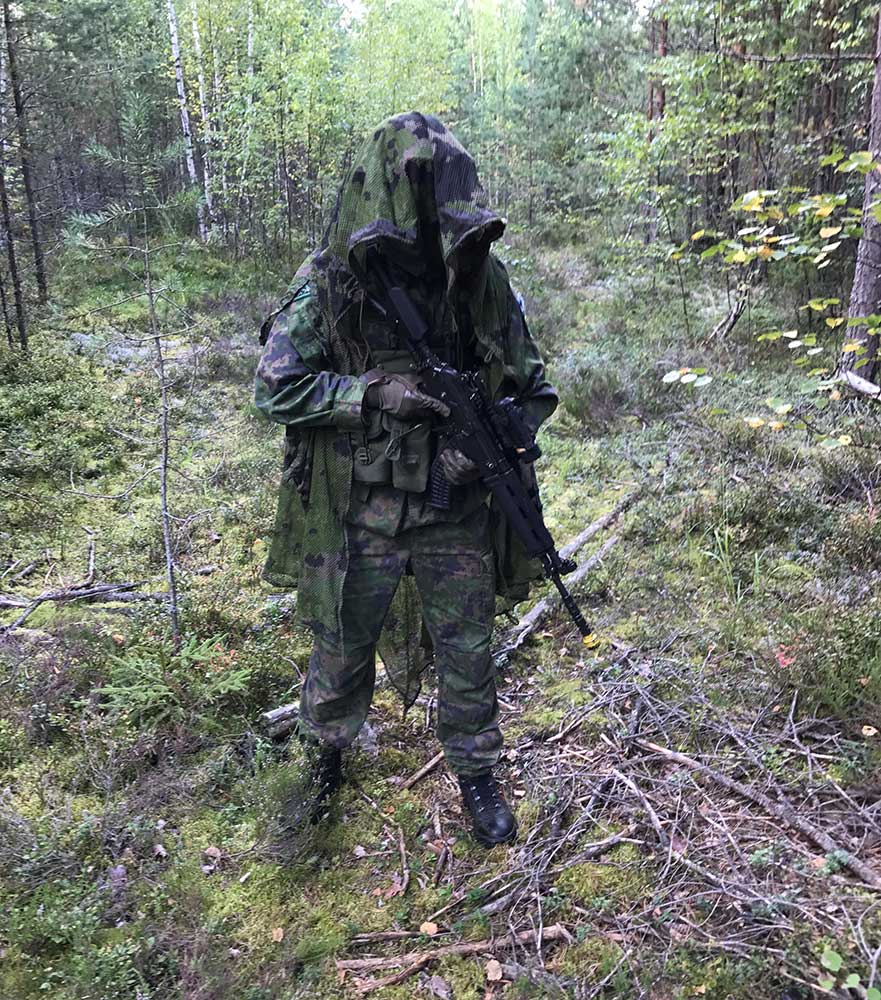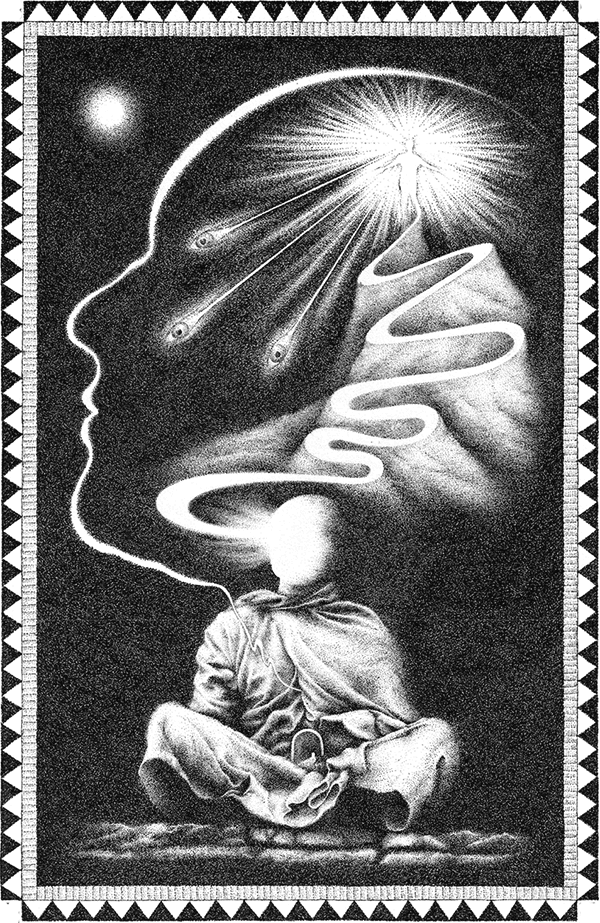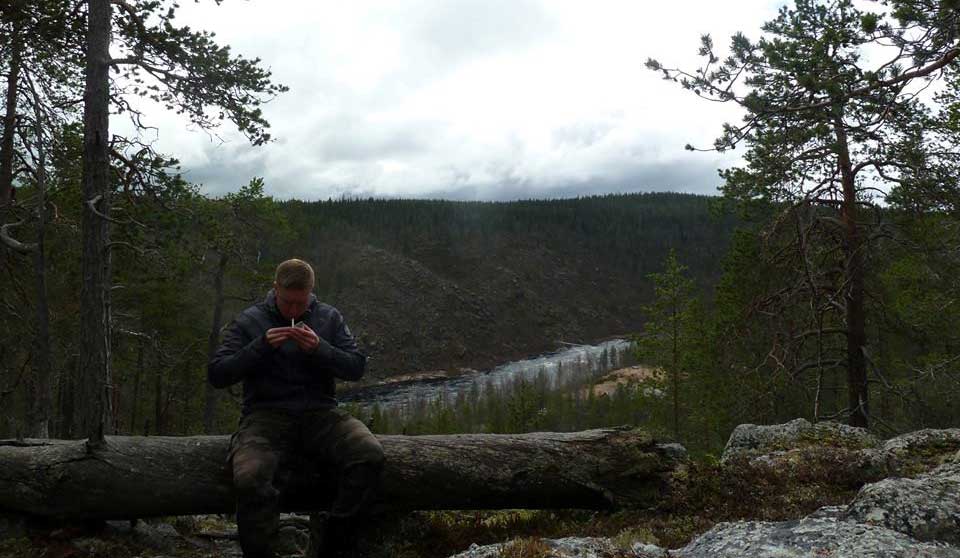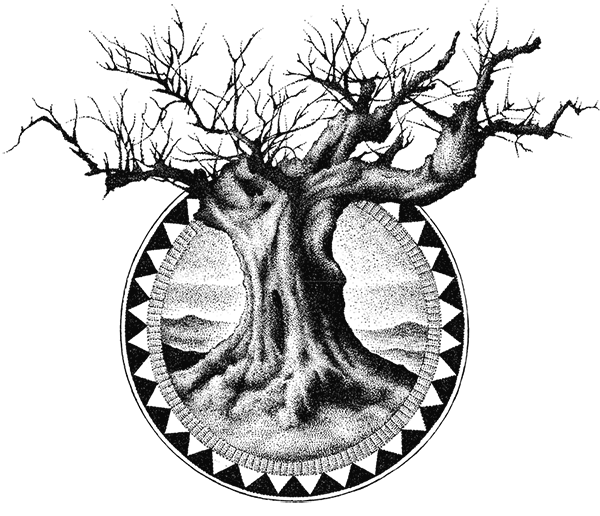W.A.I.L.
2020-01-22
by Niklas Göransson
Fighting spirit, sacred saunas, and eclectic aspirations to embody the all – a conversation about heritage, war, and nature with Finland’s doom/black wanderers W.A.I.L.
The following is an excerpt from the full article, which is significantly longer and published in Bardo Methodology #5. The same issue also includes conversations with BLASPHEMY, DAUTHA, CLANDESTINE BLAZE, ACRIMONIOUS, ROME, LYCHGATE, MORBOSIDAD, Nuclear War Now!, Cult Never Dies, MYSTIFIER, WINTERFYLLETH, and PHURPA.
– Our second album, says guitarist A.E., “Wisdom Through Agony into Illumination and Lunacy vol. II”, was completely recorded, mixed, and mastered by 2013. After a self-released promotional cassette containing the record’s conceptual material, everything else was ready in 2014 but it took an additional three years before the booklet fully materialised. Our album explores notions of singularity, the interconnectedness with all. I was consumed with the idea of tying together everything involved in this album – from photos to thematic content – everything tailored towards a whole that itself, when split apart, is like a miniature of the main concept. For example, there’s a piece of deadwood in our drummer’s picture; a deep inside-symbolism hinting at his other, more personal musical project. Furthermore, each lyric contains a nod to the previous song by referencing its name and theme in some way.
The primary reason I find myself conversing with these gentlemen is that Mikko Aspa of CLANDESTINE BLAZE turned me on to W.A.I.L. Among other things, he noted that they’re not, and I quote, ‘typical internet slobs’.
– I am a professional soldier, says vocalist P.R., an occupation in which physical and mental strength is indeed both something that’s required and actively trained. Maybe that qualifies as not being an ‘internet slob’? For me, this occupation is no regular nine-to-five job as much as a reflection and part of who I am – and it shines through in my contributions to the band. The same elements I train in this line of work also serve as driving forces behind my musical activity. As in my military career, I also try to cultivate various mental aspects through W.A.I.L.; the motto ‘Train as you fight’ applies to our band activities as well.
– To be honest, A.E. continues, I wouldn’t call anyone in the band a ‘slob’ – we all have a lot going on in our lives regarding both the mental and physical. This in itself is nothing too special though, or at least it shouldn’t be. I study history, religion and political science at university. Although it must be said that much of what I, at the moment, consider to be the most insightful knowledge regarding various subjects falling under those umbrella-terms are things I’ve picked up outside the academic setting. Authority doesn’t always equal the most truthful or knowledgeable, especially in this day and age when many fields of Western universities have gotten so heavily politicised. As for physical exercise, I’m really big on weightlifting. Often, my most inspiring and meaningful weekday moments take place whilst pumping iron and listening to music or some podcast. Or when I’m reading something revelatory regarding philosophy, metapolitics, and so on… or walking, swimming, relaxing and contemplating in nature. Pretty standard stuff for many reading this interview, I reckon.

I’ve gotten the impression that W.A.I.L. have a rather strong bond to the wilderness. Given P.R.’s profession, I’m assuming there’s the occasional woodland sleepover involved and that he, as a result, might have a slightly more sober view on nature compared to us urbanites.
– Nature has always been very important to me, says P.R., during my childhood and youth I lived in a pretty remote location. Our yard ended where a lake and forest began, so nature has been a constant and direct part of my life since early beginnings. These days, I spend over a hundred nights of the year in the forest – mostly on behalf of my work. I’ve slept outside in freezing cold temperatures without a sleeping bag or other useful camping gear under shelters built with my own hands while eating mainly things gathered from the land. So, I don’t have a ‘nature boy’ glorification towards the wilderness anymore. For me, nature is still a place to think and focus but I’ve also gotten all too familiar with its cruelty.
A.E. says he has a particularly strong bond with Finnish nature, first and foremost.
– That’s something that comes very naturally since I’ve also been closely surrounded by it my whole life. I was born and raised in a small seaside town so, besides forests, water as an element is something I feel naturally drawn towards. The guitar melody in “Abyss” is my personal tribute to nightly ocean waves drifting aimlessly in the wind; a commemoration of all the countless hours I’ve spent pondering various matters while overlooking my hometown’s seaside. There’s also a historical connection to the passage; namely, the tragedy of Smalls Lighthouse, from which its artwork and concept derive – we felt it was fitting.
The original Smalls Lighthouse was erected in the year 1775 on a tiny island made of rock just west of Wales. While the structure proved sturdy enough in the end, the long oaken legs it stood upon tended to sway rather alarmingly in a storm. Which, given the location, meant fairly often. British lighthouses were traditionally manned by two-man teams, and when this story begins, in 1801, the team consisted of Thomas Howell and Thomas Griffith. One day, Mr. Griffith fell ill and soon deteriorated to the point where his partner felt compelled to set a distress signal. Alas, several weeks elapsed without a passing ship taking notice, during which time Mr. Griffith expired. Besides the ordeal of now having the cadaver of a former colleague on his hands, Mr. Howell was painfully aware of how the pair had been known for their fierce arguments. Consequently, simply dumping the stiff into the sea and be done with it could potentially leave him open to suspicions of foul play. As Mr. Griffith began to decompose, Mr. Howell built a crude casket out of boards from their now-obsolete dividing wall and then secured both corpse and coffin to the outside railings. The weather worsened and a hellish gale tore the makeshift carcass-container asunder, sending bits and pieces of wood flying into the ocean. The late Mr. Griffith, however, remained securely fastened and could regularly – when the winds were howling in a certain direction – be spotted flapping about outside the window, apparently giving the unnerving impression of waving vigorously. Due to continued poor weather, it took four entire months before help was able to arrive, and during this time Mr. Howell had no means of communication. The sole watchman managed to keep the lamp lit for all of his lonely vigil, with a gradually decaying co-worker’s occasional wind-dependant appearances as only social exchange. When retrieved and relieved, at long last, Thomas Howell was said to have looked only marginally healthier than Thomas Griffith. The experience left the poor bastard quite mad and deformed his physical appearance to the extent that friends back home could no longer recognise him. This tragedy led to an immediate change in working policies for lighthouse crews, mandating them to always be at least three on active duty.
– I also love outdoor activities and have gone on several hikes in Lapland with close friends. Being in complete wilderness where there are endless forests, mountains, rivers, and lakes is really something that’s hard to put into words. Sure, freedom might be a really cliched way of describing it but that’s really the most suitable term I can think of for now. It frees you from the many rotten aspects of big cities or even modern towns or villages – but along with that freedom also comes increased responsibility. For example, you can’t just call somebody when unexpected situations arise because your cell-phone has no signal for tens of kilometres in either direction. Consequently, you have to rely entirely on yourself and your comrades; assuming there are other people with you, of course. It’s a test of one’s character and in some ways a brief glimpse into a world I’d otherwise have no clue about. Perhaps one could call it a modern mirror of our more distant past. Of course, it’s also just a vacation of sorts but one could certainly say that the call of the wild is an urge from the primeval within man.

W.A.I.L. are currently recording two new releases, one of which is a rather personal project where they’ve all chosen from their family tree one grandfather who fought in the Winter War. When the Soviet Union invaded Finland in 1939, the defenders’ armed forces initially consisted mostly of new conscripts garbed in private winter wear with makeshift insignia stuck on the jacket; only soldiers in active service had been issued proper uniforms. Nevertheless, they were soon provided the all-white gear which, complemented by superior skiing skills, lent their guerrilla tactics such remarkable success. Most Soviet troops weren’t able to ski and so had their movements restricted to walking on roads in long columns, leaving them vulnerable to ambushes. As the Soviets invaded on November 30, they were blissfully unaware of the exceptionally cruel winter lying in wait for them. Largely bereft of proper arctic clothing, some 61,500 Soviets were stricken by frostbite and related ailments. A record low of below forty-three degrees Celsius (− 45 °F) was noted in the Karelian Isthmus. This was a terrain unsuitable for guerrilla warfare so the Finns had to rely on a more conventional defensive fortification known as the Mannerheim Line. While the name might sound robust enough, its most reinforced section boasted only one concrete bunker per kilometre. Instead, the Finnish attribute the Line’s firm resolve to its wardens’ ‘sisu’, an idiom meaning something like ‘fighting spirit’. Plenty of sisu was required on December 19, when twenty Soviet tanks broke through the scarce line as part of a major assault on Summa. The Finns lacked anti-tank weaponry and so could do little but remain in their trenches, trying to stave off the incoming Red Army while armoured vehicles roamed uncontested and wrought havoc all around. Once the incoming infantry had been repelled, the tanks stranded behind enemy lines were burnt out using a recent innovation in the form of bottled petrol bombs called Molotov cocktails – named after the Soviet foreign minister. The Mannerheim Line held, as the increasingly demoralised invading troops simply refused to engage in further suicidal assaults. Equally impenetrable was the improvised stronghold of Kollaa; having been pushed back twenty-five kilometres into Finland, the natives dug in with all their might around a stream with strong natural defences. Their odds were not exactly spectacular, given that they were outnumbered threefold in manpower, fivefold in artillery and entirely in the air. This contest went on until the end of the war, giving rise to the motto ‘Kollaa kestää!’, or ‘Kollaa holds!’ The Karelian theatre also cemented the legacy of fabled sniper Simo Hayha, credited with over five hundred kills, who struck such terror into the enemy that they named him ‘the White Death’. Similar feats took place all over the 1,340-kilometre-long frontier but – due to being heavily outgunned, outnumbered, and with little help coming from abroad – the situation had become particularly dire by mid-February. The Soviets were in no mood to keep going either, having been gravely embarrassed internationally by the stubborn Finns’ refusal to yield ground. With spring thaw incoming, there was a risk of Soviet forces getting bogged down in the forest. While the entire frontline saw heavy fighting, negotiations were underway and a peace treaty was signed on March 12. According to the terms, Finland was forced to cede large land masses such as parts of Karelia, including the country’s second-biggest city, Vyborg, along with a lot of industrialised territories.
– Each of us delves into the lives of our chosen ancestor and dedicates to them one song, A.E. explains. The original idea was to make this into a mini-cd but it appears to be turning into our third full-length instead. I chose my paternal grandfather, so I’ve been reading letters he sent from the front and generally gathering as much information as I’ve been able to. Thus far it’s been a very intimate, rewarding, and fruitful project – just as I envisioned it would. However, I want to stress that this release is not about Finland in World War II; both the Winter War and Continuation War are somewhat prevalent only because they were big parts of all of our grandfathers’ lives. Its true conceptual core is the study of philosophical and spiritual questions from the perspective of our forebears, explored through the themes found in our acronym. This release is a Finnish ancestral ritual through which we emanate the All.
The other is a full-length split with eccentric Finnish black metal solo project MISANTROPICAL PAINFOREST.
– The concept is a study of the relation between man and cosmos. Or to put it bluntly, what is our place and meaning in the universe and what is its nature? We’re honoured to be working together with such a unique and visionary act and consider this union very fitting: two weirdo Finnish metal bands with peculiar yet somewhat similar characteristics. Maybe it’s the oddball Finnishness that’s the primary unifying factor between us.

What does being Finnish mean to you?
– Explaining this to any degree of satisfaction is almost impossible because the intuitive essence of Finnishness stems from a source that’s partly spiritual. One could say the Finnish folk-soul is a synthesis of the nation’s genealogy and nature and whose roots lie in a deeply mystical general derivation of the Europid sub-species; a unique genetic and cultural amalgamation of Eastern and Western European influences. Many times, you just understand that something is uniquely Finnish but why this is cannot really be satisfyingly conveyed in normal conversation. You just know because it’s a very close manifestation of fundamental parts of yourself.
Besides proclivities towards vodka and knives, often in combination, here in Sweden we associate our easterly neighbours with ‘det finska vemodet’ – the Finnish melancholy.
– We surely have an identifiable expression of melancholy; general gloominess is a strong aspect of the natural expression of the Finnish folk soul. And sure, alcohol also plays a pretty big part in all of that. Despite my lively personality, I’m still also very drawn to melancholy and like my spirits… sometimes way too much. But this is certainly not the only side of Finnishness and I sincerely believe many overplay its significance. Another relevant aspect is the concept of personal honour, doing your duty and being just, kind, and righteous towards others. What might not be spoken about all that much, but which is also a sizable part of the whole, is this certain kind of laid-back and humorous attitude towards life. And by humorous, I don’t mean any kind of cynical-ironic USA hipster bullshit but, for example, what we call ‘reteys’; an easy-going and humorous life-affirming boldness even in the face of great adversity. One of the most revered Finnish artists – Antti Hammarberg, aka Irwin Goodman – has many legendary hits that embody this side of Finnishness, with one example being a great song called “Reteesti Vaan”. I also believe W.A.I.L. radiates all of these aspects of the Finnish folk-soul, although many seem to only pick up on its most obvious dark and melancholic aspects. If one digs deeper though, among the darkness and death one can also find some reteys as well as other life-affirming sentiments in our metal of KRS.

This was an excerpt from the full article, which is significantly longer and published in Bardo Methodology #5. The same issue also includes conversations with BLASPHEMY, DAUTHA, CLANDESTINE BLAZE, ACRIMONIOUS, ROME, LYCHGATE, MORBOSIDAD, Nuclear War Now!, Cult Never Dies, MYSTIFIER, WINTERFYLLETH, and PHURPA.



